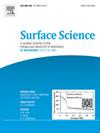Ultrathin epitaxial aluminum oxide film on 4H-SiC(0001) surface
IF 1.8
4区 化学
Q3 CHEMISTRY, PHYSICAL
引用次数: 0
Abstract
The oxide/SiC interface is important for devices based on SiC. The major concern for application is electron scattering due to the large amount of interface defects. Here we report an epitaxially grown ultrathin aluminum oxide film on 4H-SiC(0001) by co-annealing an AlO ceramic plate and a 4H-SiC(0001) substrate in hydrogen atmosphere. The result is ()R surface capping structure, which remains stable after exposure to air. This ultrathin oxide exhibits a band gap of . The structural information inferred from X-ray photoemission spectroscopy and x-ray crystal truncation rod scattering suggests that there are almost no dangling bonds in the film and at the interface.

4H-SiC(0001)表面超薄外延氧化铝膜
氧化物/SiC接口对于基于SiC的器件非常重要。由于大量的界面缺陷,应用中主要关注的是电子散射问题。在这里,我们报道了通过在氢气气氛中将Al2O3陶瓷板和4H-SiC(0001)衬底共退火,在4H-SiC(0001)上外延生长超薄氧化铝薄膜。结果是(33×33)R30°表面盖层结构,暴露于空气后保持稳定。这种超薄氧化物的带隙为~ 6eV。从x射线光发射光谱和x射线晶体截断棒散射推断出的结构信息表明,薄膜和界面上几乎没有悬空键。
本文章由计算机程序翻译,如有差异,请以英文原文为准。
求助全文
约1分钟内获得全文
求助全文
来源期刊

Surface Science
化学-物理:凝聚态物理
CiteScore
3.30
自引率
5.30%
发文量
137
审稿时长
25 days
期刊介绍:
Surface Science is devoted to elucidating the fundamental aspects of chemistry and physics occurring at a wide range of surfaces and interfaces and to disseminating this knowledge fast. The journal welcomes a broad spectrum of topics, including but not limited to:
• model systems (e.g. in Ultra High Vacuum) under well-controlled reactive conditions
• nanoscale science and engineering, including manipulation of matter at the atomic/molecular scale and assembly phenomena
• reactivity of surfaces as related to various applied areas including heterogeneous catalysis, chemistry at electrified interfaces, and semiconductors functionalization
• phenomena at interfaces relevant to energy storage and conversion, and fuels production and utilization
• surface reactivity for environmental protection and pollution remediation
• interactions at surfaces of soft matter, including polymers and biomaterials.
Both experimental and theoretical work, including modeling, is within the scope of the journal. Work published in Surface Science reaches a wide readership, from chemistry and physics to biology and materials science and engineering, providing an excellent forum for cross-fertilization of ideas and broad dissemination of scientific discoveries.
 求助内容:
求助内容: 应助结果提醒方式:
应助结果提醒方式:


